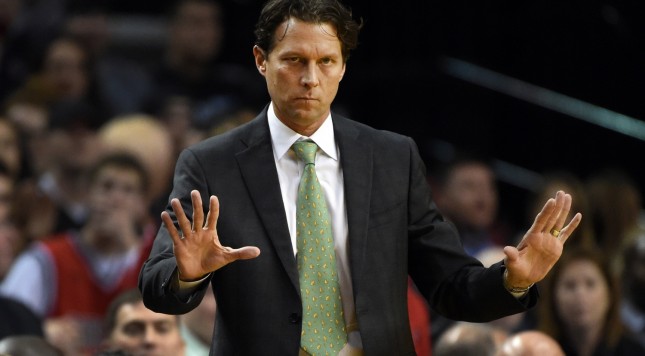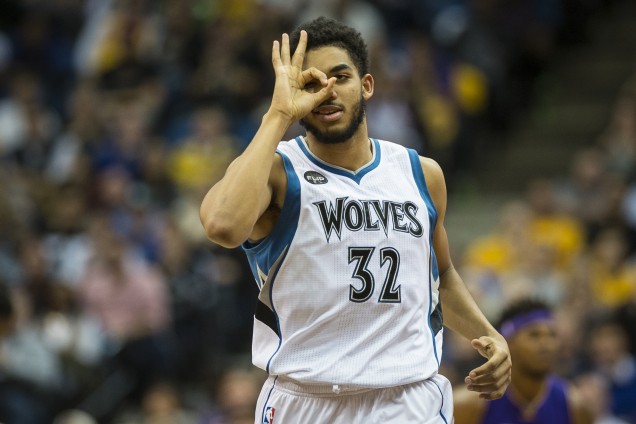The Utah Jazz were stung near the end of the season by established veterans who used to play for them.
The Jazz will feel the pain of their loss to Dallas — and their inability to make the playoffs — over the next several months. Yet, if the Jazz lost the battle in 2016, they’re in position to win the war over the next several seasons.
Much of the story of the 2016 Jazz is found in this reaction to the Dallas loss and the final-week fade which turned a promising situation into the emptiness of mid-April tee times. The Jazz could have benefited so much from the simple act of playing the Golden State Warriors in the first round. The series might have ended in a four-game sweep, but the mere reality of being tested and exposed by the reigning NBA champions would have given a young team valuable experience moving forward.
Yet, while the Jazz won’t get that chance, their youth — so much a curse within the context of this season alone — is a blessing in the future. Growing pains, for the team and for coach Quin Snyder — who frankly did a very good job this season — should enable Utah to take the next step, as long as the injury bug is kinder to Utah in 2017.
You can’t render a complete verdict on this season in Salt Lake City without noting the toll caused by injuries — to Rudy Gobert, Alec Burks, and Dante Exum most of all. The lack of depth on the roster, and the lack of Exum’s presence at the point, contributed to the slow pace with which this team played (dead last in pace at 91) and the lack of shot volume despite a No. 10 league rating in offensive rebounds. Utah wasn’t an awful shooting team, but it wasn’t an especially good shooting team, either. Middle-of-the-pack ratings combined with low shot volume were more than enough to keep the Jazz at the bottom of the league in scoring, averaging under 98 points per game (29th out of 30 teams).
With better injury luck next season, the Jazz should be able to win several more games. If the first four spots in the Western Conference’s hierarchy are spoken for, Utah would certainly have a chance to be fifth with merely moderate luck — more precisely, the mere absence of bad luck.
What has to give the Jazz and their fans so much hope for the future is that their 2016 roster did not include a single player older than 28. Of all the players on the team who averaged at least 21 minutes per game this season, not one was older than 25.
General manager Dennis Lindsey drafted well. His Trey Lyles selection has become a very good move, based on Lyles’s quick evolution this season, particularly as a corner 3-point shooter. Further development in that facet of play will make the Jazz’s offense more formidable in the years to come. Rodney Hood must learn how to earn more free throws when his jumper isn’t falling, and Gordon Hayward still has a higher ceiling to reach as a crunch-time scorer, but these are evolutionary issues, not crises. Snyder has brought this team along to the point that if all of its resources are on hand, the project should become a success.
Here’s the main concern for the Jazz, something external rather than internal:
The Minnesota Timberwolves — especially since they’ve parted ways with coach Sam Mitchell — are likely to make a big jump in the next few seasons. The Denver Nuggets, stocked with promising youngsters much like the Jazz, are also headed on an upward trajectory — probably not to the extent the T-Wolves will rise, but enough that they should contend for a back-end Western Conference playoff spot next season.
There’s nothing “Northwest” about Minnesota, but the T-Wolves — like the Nuggets — join Utah in the Northwest Division. The division could be the toughest in the league next season if Minnesota and Denver both evolve at a fast rate. Utah could conceivably gain ground in terms of its overall record yet not make all that much headway in the West.
Remember this: The West’s 8 seed was a mid-to-upper-40s team (in terms of wins) the previous few seasons. This year marked the first time since 1999 that the East’s 8 seed had a better record than the West’s 8 seed.
The point the Jazz must absorb (and work very hard to address) is that if Minnesota and Denver live up to their own expectations and hopes, the West — maybe not in 2017, but certainly in 2018 — will probably be deep enough again that the 8 seed will need to win 45 games.
Improvement is something we’re certain to see from the Jazz. If other teams improve more, however, Utah’s youth project won’t get anywhere. That’s the organization’s main concern… other than injuries.
The story of the Utah Jazz — in this brave new world — is just beginning to be written. Some elements of this team’s future lie very much within its own capacities, but the fascinating variable is the extent to which forces beyond the organization’s control shape the destiny of these Jazzmen.



